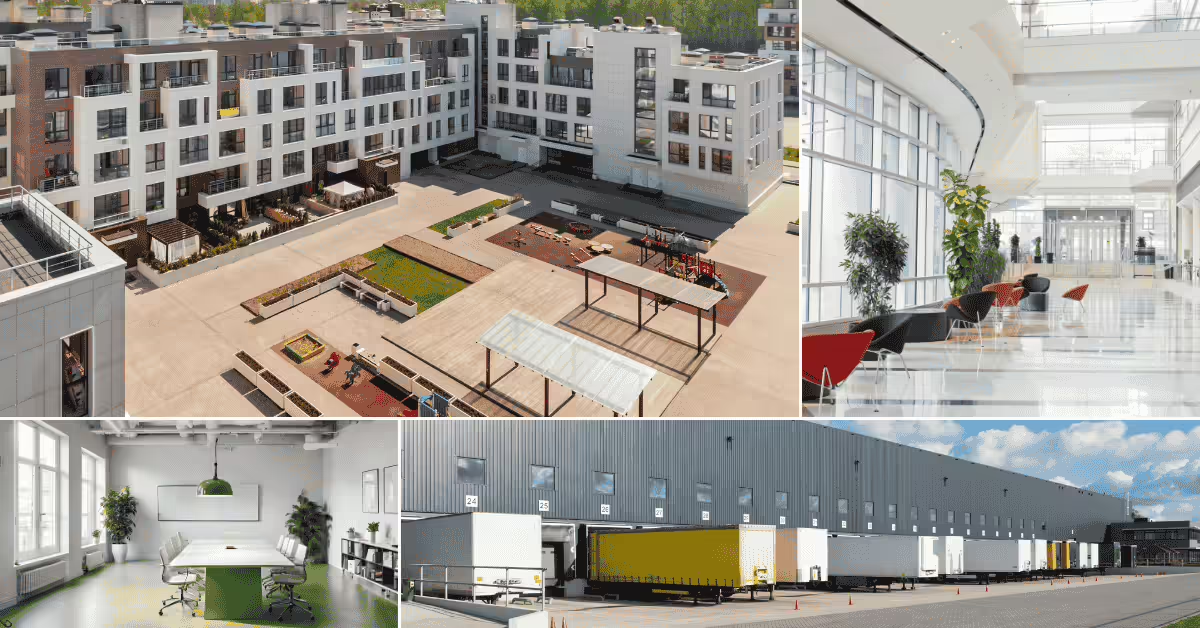Leasing commercial property? Don’t let simple mistakes cost you big. From hidden fees to overlooked clauses, this guide walks you through what to avoid and why it matters.

Top 47 Commercial Real Estate Terms – A Beginner’s Guide
Navigating the world of commercial real estate can be challenging, especially if you’re new to the industry. But understanding the key terms and concepts can make a world of difference! From leasing jargon to investment metrics, the language of the industry can be intimidating, but learning it can empower you to make smarter, more confident decisions.
Whether you’re an investor, a tenant, or simply curious about the market, this will walk you through the top commercial real estate terms you should know and see how Moore Company Realty can help you succeed.
Why Understanding Real Estate Jargon Matters
Financial clarity builds confidence. Studies show that financial misunderstandings are one of the top contributors to failed business relationships and strained investments. Another study found that first-time investors who understood basic commercial real estate vocabulary felt more secure and made better decisions.
Knowing these commercial real estate terms, especially for beginners, helps you ask the right questions, communicate effectively with brokers or landlords, and spot opportunities others might miss. It’s not about memorizing definitions, it’s about knowing what to look for and how to evaluate a deal confidently.
Key Commercial Real Estate Terms Explained
We’ve grouped the terms below by category to help you navigate easily. This structure is especially helpful if you’re looking for information on leasing, investing, or property management.
Leasing Terms – Commercial Real Estate Terms
Anchor Tenant
An anchor tenant is the primary tenant in a shopping center or office complex that draws in other tenants and customers. For example, a large grocery store acting as an anchor tenant in a retail plaza can attract significant foot traffic, benefiting smaller businesses in the same location.
Build-Out
Build-out refers to the process of preparing leased commercial space for occupancy, including modifications like adding walls or electrical outlets to suit a tenant’s needs.
Build-Out Allowance
This is the funding provided by a landlord to cover the cost of customizing a space for the tenant. For example, a landlord might offer a $50,000 build-out allowance to a new restaurant tenant to help with installing a commercial kitchen or custom seating, reducing the tenant’s initial costs.
Build-to-Suit
In a build-to-suit arrangement, a commercial property is developed specifically for a particular tenant, customized to their needs. For example, if a tech company requires a facility with advanced server rooms and specialized HVAC systems, the developer will design and construct the building to match those specifications.
Common Area Maintenance (CAM)
CAM fees are paid by tenants to cover the cost of maintaining common areas, like lobbies and hallways. For example, tenants in a shopping center may pay CAM fees for parking lot maintenance and landscaping.
CAM Cap
A CAM cap limits the amount a landlord can charge for Common Area Maintenance fees.
Delivery/Delivery Date
The delivery date refers to when a commercial building is completed and ready for occupancy.
Escalation Clause
An escalation clause in a lease allows for periodic rent increases. For example, a commercial lease might include an escalation clause that increases rent by 2% each year.
Full-Service (FS) Rental Rate
A full-service rental rate includes all operating expenses, such as utilities and maintenance, so tenants pay one inclusive rent amount without additional monthly costs.
Gross Lease
In a gross lease, the tenant pays a flat rent, and the landlord covers expenses like property taxes, insurance, and maintenance.
Lease Term
The lease term is the length of time a commercial property lease agreement is in effect.
Load Factor
The load factor accounts for common areas in a commercial building that tenants share, like hallways and lobbies. It’s calculated by dividing the rentable square feet by the usable square feet. For example, if a tenant’s usable office space is 1,000 square feet and the load factor is 15%, they’ll be charged for 1,150 square feet of rentable space.
Modified Gross (MG) Rental Rate
A modified gross rental rate includes some operating expenses, with others paid separately by the tenant. A commercial tenant might pay a modified gross rental rate that covers base rent and property taxes, while utilities are paid separately.
Net Lease
In a net lease, the tenant pays a base rent plus a portion of the commercial property’s operating expenses, such as property taxes and insurance.
Option to Renew
An option to renew is a commercial property lease clause that gives the tenant the right to extend the lease term under predefined conditions.
Per Square Foot (PSF)
PSF is a standard measurement for calculating rental rates and property values.
Preleased Space
Preleased space is space that has been leased to a tenant for future commercial development that hasn’t been built yet.
Second Generation Space
Second-generation commercial space has been previously occupied and may have existing modifications that can save on build-out costs.
Shell Space
Shell space is a commercial building space with an unfinished interior that requires improvements.
Sublease/Sublet Space
Sublease or sublet space is space that a commercial tenant leases to another tenant.
Subordination
Subordination is an agreement that prioritizes one party’s interest over another’s in debt repayment. For example, a commercial real estate lease might be subordinated to a mortgage, giving the lender priority in case of default.
Tenant Improvement (TI)
Tenant improvements are modifications made to a commercial rental space to meet the tenant’s needs.
Triple-Net (NNN) Rental Rate
A triple-net rental rate excludes all operating expenses, which are paid directly by the tenant.
Useable Square Feet (USF)
USF is the actual space a tenant can use within the walls of the leased premises.
Investment & Financial Terms – Essential Commercial Property Terms for Investors
Amortization
Amortization is the process of gradually paying off a loan through regular payments over time. If you take out a $500,000 commercial real estate loan with a 20-year term and a fixed interest rate, your monthly payments will cover both principal and interest. Over time, more of your payment will go toward the principal balance.
Capitalization Rate (Cap Rate)
The cap rate measures the expected return on investment for a commercial property. It’s calculated by dividing the Net Operating Income (NOI) by the property’s value. For instance, if a building has an NOI of $10,000 and a cap rate of 5%, the property’s value would be $200,000.
Cash-on-Cash Return
This metric measures the annual pre-tax cash flow relative to the total cash invested in the property. If you invest $200,000 in a commercial property and receive $20,000 in cash flow annually, your cash-on-cash return is 10%.
Debt Service Coverage Ratio (DSCR)
DSCR measures a commercial property’s ability to cover its debt obligations with its net operating income (NOI). For instance, if a property has an NOI of $120,000 and debt payments of $100,000, the DSCR is 1.2, indicating that the property earns 20% more than necessary to cover its debt.
Escrow
Escrow is an arrangement where a third party holds funds or documents until specific conditions are met. During a commercial property purchase, funds might be held in escrow until the sale is finalized.
Gross Operating Income (GOI)
GOI is the total income generated from a commercial property before deducting operating expenses. For example, if an apartment building earns $120,000 in rent and $30,000 from parking fees, the GOI is $150,000.
Letter of Credit (LOC)
An LOC is a financial document from a bank guaranteeing that a buyer’s payment to a seller will be received on time and for the correct amount.
Letter of Intent (LOI)
An LOI is a document outlining the proposed terms of a deal, serving as a preliminary agreement.
Net Operating Income (NOI)
NOI represents the commercial property’s income after deducting operating expenses, excluding debt service and income taxes. For example, if a property generates $100,000 in revenue and has $30,000 in operating expenses, the NOI is $70,000.
Operating Expenses
Operating expenses are costs associated with owning or leasing a commercial property, such as maintenance, taxes, and insurance.
Pro Forma
A pro forma is a financial statement that projects the future income and expenses of a commercial property.
Rent Roll
A rent roll is a report listing all tenants, rental amounts, lease terms, and other vital information about a commercial property.
Rentable Square Feet (RSF)
RSF is the total square footage that can be leased, including common areas like hallways.
Return on Investment (ROI)
ROI measures the profitability of a commercial real estate investment.
Right of First Refusal
This clause gives a commercial tenant the option to lease additional space before the landlord offers it to others.
Roles & Operational Terms – Commercial Real Estate Vocabulary Explained
Broker
A commercial real estate broker represents buyers, sellers, landlords, or tenants in transactions. They help you find the perfect commercial property or negotiate the best lease terms.
Certificate of Occupancy
This document confirms that a commercial building complies with building codes and is ready for occupancy.
Central Business District (CBD)
The CBD is the main commercial and business center of a city, often located downtown. Properties in the CBD are usually in high demand due to their prime location.
Property Manager (PM)
A commercial property manager oversees all operational aspects of a building, such as maintenance and tenant relations.
Tenant Representation
Tenant representation occurs when a commercial broker represents a tenant in lease negotiations.
Vacancy Rate
The vacancy rate is the percentage of unoccupied rental space in a commercial property.
Learning commercial real estate terms isn’t just for pros, it’s a smart move for anyone who wants to invest, lease, or understand the market better. Use this guide as a reference anytime you’re dealing with a property decision or contract.
At Moore Company Realty, we’re committed to helping you make informed decisions in the commercial real estate market. With our deep expertise in the Central Alabama area and beyond, we’re here to guide you every step of the way. Whether you’re buying, selling, or leasing, our team is dedicated to finding the right property that fits your needs and goals.



